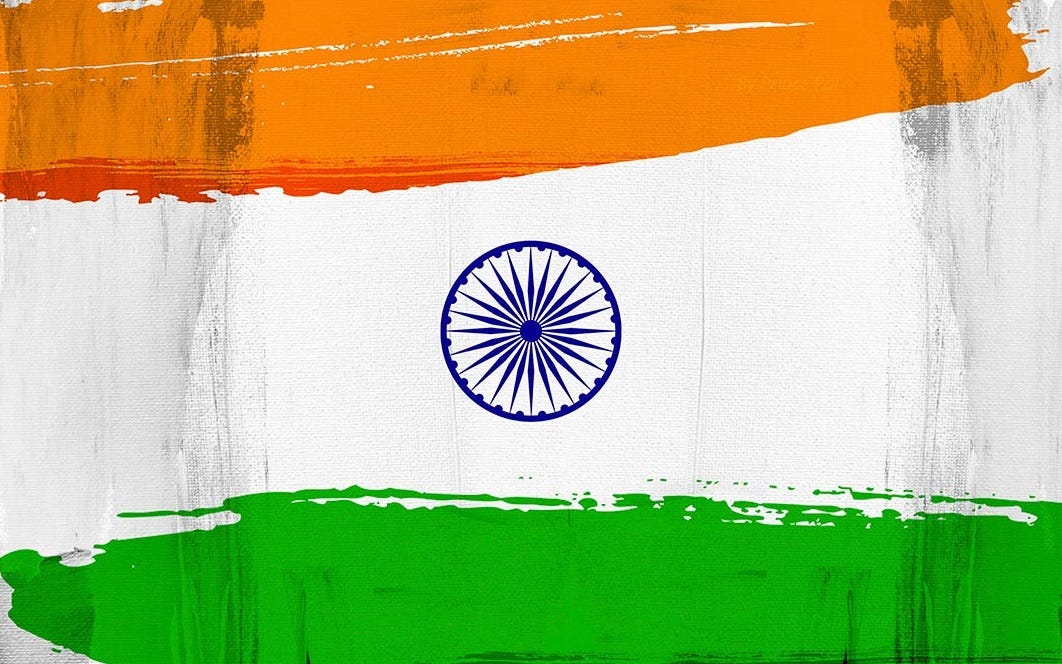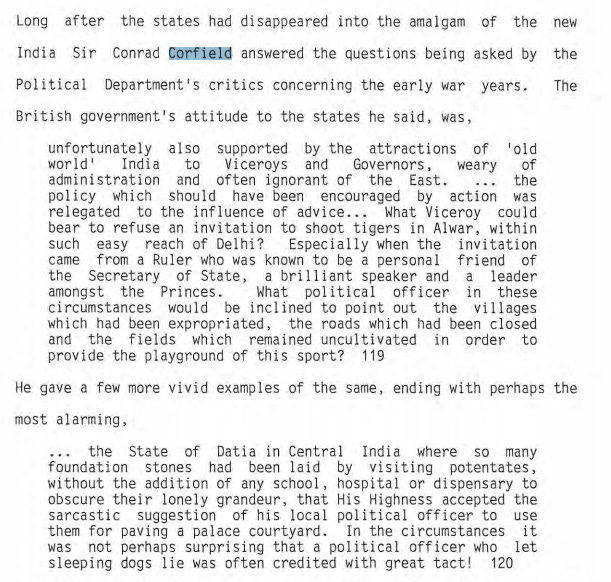Insightful newsletter of Drishtikone: Issue #313 - Subterfuge and India's Freedom
India's independence came at a heavy price. Characters at that time were responsible for that. A look in 'what happened' and 'why'.
“The aim of life is no more to control the mind, but to develop it harmoniously; not to achieve salvation here after, but to make the best use of it here below; and not to realise truth, beauty and good only in contemplation, but also in the actual experience of daily life; social progress depends not upon the ennoblement of the few but on the enrichment of democracy; universal brotherhood can be achieved only when there is an equality of opportunity - of opportunity in the social, political and individual life.— from Bhagat Singh's prison diary, p. 124”
Salaam or Shalom is known as peace in Arabic and Hebrew. It is their highest greeting and aspiration. Peace. Because the greatest strife they have realized in their lives is war and chaos. Dar el Harb, for example, are the lands of non-Muslims. Harb means War. Dar means House. The lands of Muslims are known as Dar el Islam or Dar el Salaam. Or House of Peace.
The unmistakable message - My House (my rules and the rest of it) means Peace for you, your house means war for me.
Peace is only when one is my way. Any other way of how the ‘other’ thinks is a cause of war.
Just that - the idea of the world different from mine is an act of war.
A mindset and a civilization that believes war is not just necessary but a divine edict for a belief different from mine can only aspire for peace that emanates from a certain set of ideas.
Anything outside that set of ideas is strife.
That is why Peace.
Self-styled, self-defined, and self-mandated - confining and invasionary - is what that mind aspires for.
The Indian civilization did not care much for peace. Specifically, that was defined by one to be followed, nay forced upon everyone else.
This civilization did not just root for a free mind but freedom from the limitations of the mind itself.
Mind is an accumulation of ideas, thoughts, prejudices, and impressions one has gathered over one’s lifetimes and that of others. Such a life, confined by the limitations of the mind’s impressions, cannot express itself fully.
Forget about rising to the highest.
Freedom from all limitations was not just an idea or confined to an aspiration. It was a goal that the entire society worked towards. Many attained to it.
Moksha. Nirvana.
That is why the words of Shaheed Bhagat Singh are so important.
“Realize Truth, Beauty and Good not only in contemplation but also in the actual experience of daily life”
This Independence Day, let every child of this vast Indian civilizational ethos, work for a life of complete liberation. From all limitations.
As an actual experience of daily life.
Happy Indian Independence Day!
Machinations and Subterfuge Surrounding the days leading up to India’s Independence
On February 20, 1947 Clement Atlee announced in the House of Commons that “His Majesty’s Government intended to transfer power to responsible Indian hands by a date no later than June 1948.”
“Responsible Indian hands.” Interesting choice of words.
When Mountbatten came to India sworn in as the last Viceroy on March 22, 1947, he was therefore given a clear objective by the then British Prime Minister Clement Atlee. To transfer power in India by June of 1948. He had until October 1, 1947, to decide whom to outline steps of the transfer if a unified government in India was not a possibility.
The options were One Government, Two Governments or multiple if the power had also to be transferred to multiple princely states.
But within three weeks, he was talking of partition as being the only solution.
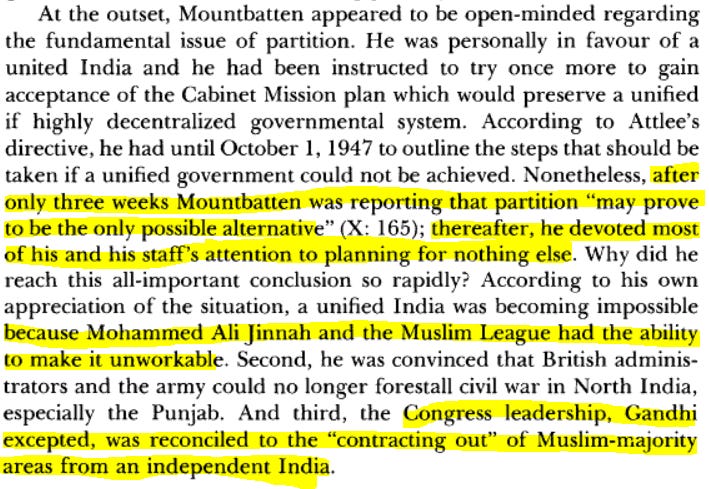
Important thing is that Congress was predisposed to partition, yet it did not warn people!
Corfield - the Machiavellian character and his Balkanization Plan
Sir Conrad Laurence Corfield was a British civil servant who had joined the Indian Civil Services and had been the “Political Adviser to the Crown Representative” or advisor to the Viceroy. He had served Lord Willingdon, Lord Linlithgow, Lord Wavell, and finally to Lord Mountbatten.
During this period when the power was to be transferred, Corfield wanted a bigger role for himself. He had been rebuffed by Mountbatten, so he went over him to Lord Listowel, the then Secretary of State.
He had a plan to use the status of Paramountcy that the princely states had and orchestrate Balkanization of India.
Leonard Mosley in Last Days of the British Raj wrote, "The Princely States had treaties with the British Crown. Otherwise they were completely independent States, owing no sort of allegiance to British India. When the transfer of power took place, Paramountcy would automatically lapse and the Princely States would immediately get back those powers, which had been taken over by the British. In other words, all of them, the largest and the smallest of them would become independent States. They would be within their rights in expelling from their territory troops of the Indian Army, which had been stationed there in agreement with the British. Indian Railways, which ran through their States by agreement with the British, would be stopped. Indian post and telegraph offices, which operated under a franchise from the British could also be closed. Passage through the States from one part of British India to another could be barred." (Source)
Nehru was opposed to this plan (also called the Dickie Bird plan) as was Mountbatten. Nehru’s argument was that the princely states were not really independent since 'they did not have the power to declare war or conduct their own foreign affairs.'
However, Corfield was not to sit idle. He worked his way to ensure that a clause was included in the final plan where the Balkanization of India was a real possibility.
Sir Conrad was determined and he almost pulled it off. He was a master of subterfuge and he managed to convince Lord Listowel to include a clause in the Indian Independence Bill despite Nehru and Mountbatten's protestations, which lapsed Paramountcy only on the day India became independent, so that India unless it could make arrangements by agreement before hand would be confronted on August 15 by nearly 560 odd States containing a mass of 100 million people, each State completely independent. This would have resulted in chaos and as Nehru later said would have led to the Balkanisation of India. (Source)
This is what Sardar Patel had to deal with before India was to become independent. Accession of these princely states to avoid balkanization of India.
The princely states had created a special symbiotic relationship with the British establishment. (Remember this when you see the nationalistic claims of the descendants of the erstwhile rulers of those states). That is why there was a certain romance that the British establishment had with respect to their access and gifts from these states. That is what Corfield was playing to.
The machinations of Corfield notwithstanding, the Plan Balkan was rejected by Nehru and VP Menon worked on the final plan for the transfer of power.
The Plan Balkan was completed and presented on 15-16 April 1947 by Hastings Ismay to an assembly of provincial governors in Delhi. Due to this, this plan was also called “Ismay Plan“. The main proposal of this plan was that provinces should become first independent successor states rather than an Indian Union or the two dominions of India & Pakistan. As per this plan all the provinces viz. Madras, Bombay, United Provinces of Bengal, Punjab & North West Frontier etc. were proposed to be declared Independent. The states later would decide whether to join the constituent assembly or not. This plan was not discussed in detail with leaders of India and Mountbatten discussed it informally. He gave the plan a final touch and sent it to London. Later when he moved to Shimla, Pandit Jawahar Lal Nehru joined him as a guest. Here, the details of the plan were put by Mountbatten before Nehru. Nehru rejected the plan right away and told him that this plan would invite Balkanization of India and would provoke conflict and violence. Consequently, Mountbatten cabled to England and the plan was cancelled by the Cabinet. It was also called Plan Balkan. What was accepted though was the VP Menon Plan. Writing in VP Menon - The Forgotten Architect of Modern India, RP Fernando says, “VP Menon was the Constitutional Adviser to the last three Viceroys during British rule in India.” He was the only Indian in Mountbatten’s inner team. Menon’s plan for the partition of India into two Dominions was the one, which was eventually adopted. It was Menon, who realised the need to get the Princely States to accede to India before the date of independence and that Mountbatten was the ideal person to facilitate this. When the communal violence began following independence, Menon asked Mountbatten to take charge. (Source)
Corfield, however, sneaked into India while Mountbatten and Menon took the latest plan to London. His aim was to destroy the documents on the princely states and their rulers’ debauchery. 4 tons of paper was destroyed.
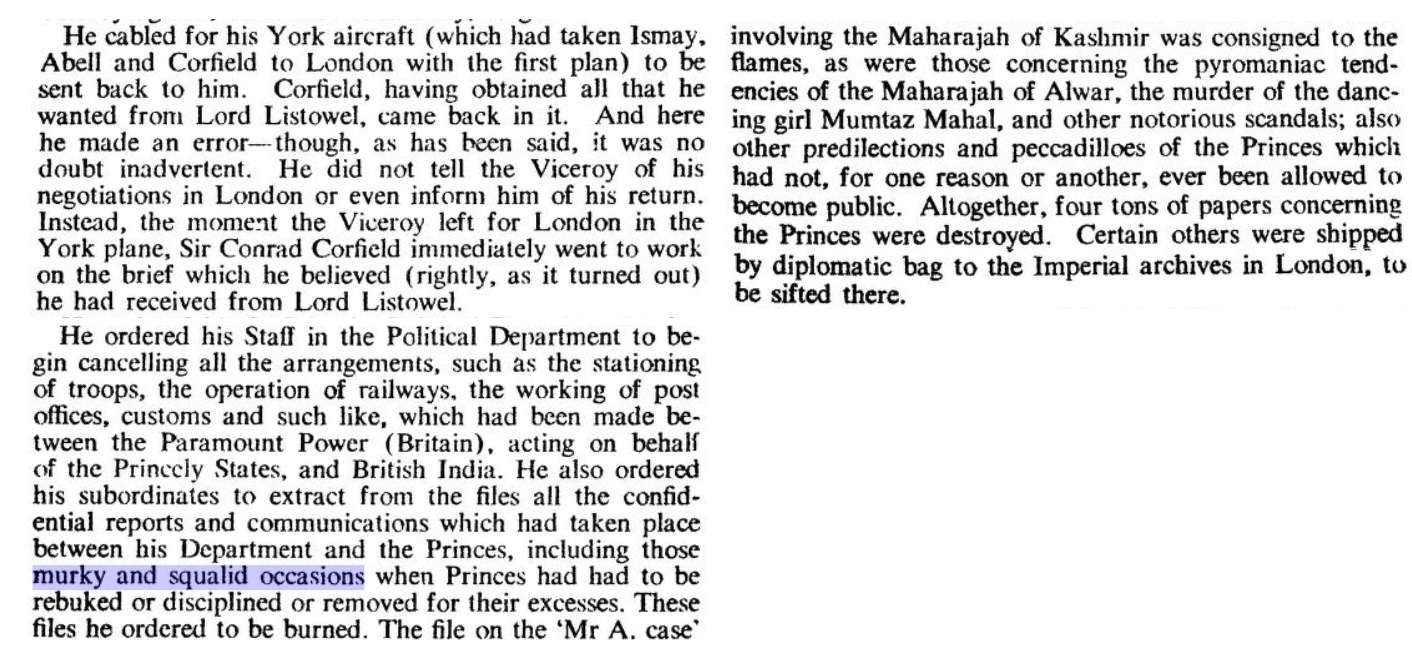
When Mountbatten returned, a meeting happened on June 13th at the Viceroy House, between Mountbatten, Nehru, Jinnah, and Corfield.
Nehru was furious that day. It is in this meeting that he fanously accused Corfield directly to his face.
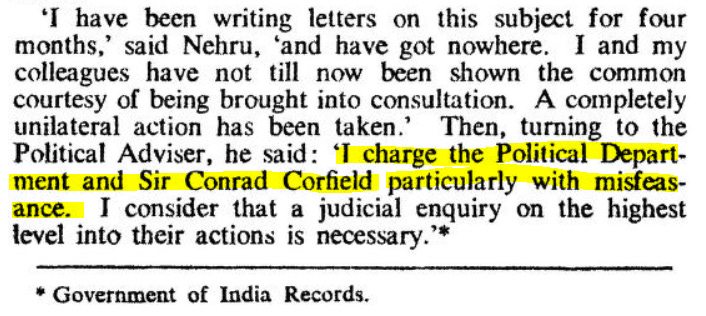
Nehru announced that a States Department would be formed to “deal with the States”. Jinnah agreed that Muslim League would do the same as well. Sardar Patel was given the charge of the States Department while V P Menon was made Secretary to oversee the transition period of integration.
Thus started the march to the new Mountbatten/Menon Plan for partition of India. A plan which included the accession of the princely states before the date of transfer of power.
Corfield’s Revenge and Vain Kings
And this is where Corfield worked hard to exact revenge from Nehru and Congress.
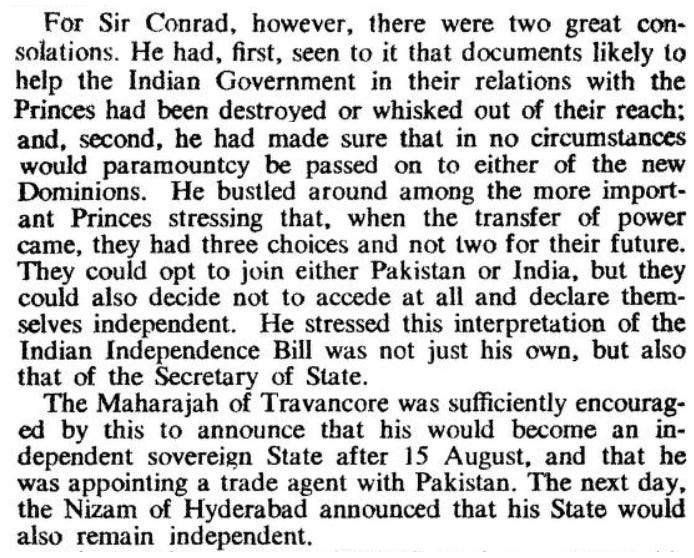
In many ways, the problem in Kashmir was the doing of Corfield.
India’s independence and the resulting partition were a play of egos of many players.
August 15, 1947 for example. Why was this date selected?
Mountbatten’s vanity.
“The date I chose came out of the blue. I chose it in reply to a question. I was determined to show I was the master of the whole event. When they asked: had I set a date, I knew it had to be soon. I hadn’t worked it out exactly then – I thought it had to be about August or September and then I went out to the 15th of August. Why? Because it was the second anniversary of Japan’s surrender.” August 15, 1945, was when Japan surrendered after it was pulverised by two nuclear bombs. The date had a personal appeal for Mountbatten as he had been Supreme Allied Commander of South-East Asia Command and had accepted the Japanese surrender himself in Singapore.
South Korea – at the time colonised by Japan – also celebrates this day as their Independence Day. In an improbable coincidence, both countries reference the same event: Japan’s surrender. (Source)
But what is most strange is that India was not fully free on August 15, 1947.
Dominion Status and Kashmir issue
On August 15, 1947 India became a dominion. That means it was a constitutional monarchy and had King George VI as the “King of India” and its head of state Something like Australia and Canada have today. It was on January 26th, 1950 that India became a republic by abolishing the monarchy. Pakistan, however, continued to be a dominion until 1956. When Queen Elizabeth was sworn in 1953, one of her titles was “Queen of Pakistan”. Even though her role was minimal in the affairs of Pakistan.
George VI was the last emperor of India, reigning until 1947, when he gave up that title in favor of two new titles for his new dominions, becoming king of India and king of Pakistan. He was king of India until that country became a republic in 1950. Upon his death in 1952, his daughter Elizabeth inherited the crown of Pakistan. Her, role, however, was minor and uneventful in her four years as queen of Pakistan. She deliberately kept from interfering in the country and her governors-general were presidents of Pakistan in all but name. For example, in 1953, Governor General Sir Ghulam Muhammad fired Prime Minister Sir Khawaja Nazimuddin for attempting to equalize the power of West and East Pakistan. The prime minister attempted to reverse this by appealing to the queen, but she refused to meddle. (Source)
Also, because India was not completely free, the first two Commanders in Chief of the Indian Army were actually British Generals.
General Sir Robert Mcgregor Macdonald Lockhart, (August 15, 1947 to December 31st 1947)
General Sir Francis Robert Roy Bucher, (January 1st, 1948 to January 15th 1949)
The first Indian Army Chief - General Kodandera Madappa Cariappa took office on January 15th 1949.
On the other side, in Pakistan, the first two Army Chiefs were also British.
General Sir Frank Walter Messervy (August 15, 1947 to February 10, 1948)
General Sir Douglas David Gracey (February 10, 1948 to January 16, 1951)
General Muhammad Ayub Khan was the first Pakistani to be their Commander in Chief.
Why is this important?
Because it was this small detail that everyone forgets when one looks at the 1948 war in Kashmir.
The role that the British played.
Let us turn to a blog written by LK Advani, the ex-Home Minister of India.
The Indo-Pak war of 1947-48 was unique in modern military history because it is the only war fought by two modern armies (belonging to two different countries), which were both commanded by British generals. The Commander-in-chief (C-in-C) of the Indian Army was General Sir Roy Bucher, and his Pakistani counterpart was General Douglas Gracey. All three services in India and Pakistan were commanded by British officers.
But by 1948, Nehru had come around to the conclusion that this was not an immediately feasible proposition. The C-in-C, General Bucher, advised him that militarily it was not possible to establish control over the entire territory of Jammu & Kashmir, with the British also supporting Pakistan. Pakistan suspected the Maharaja wanted to accede to India and tried to pre-empt his decision by forcibly seizing the state.
A cabinet meeting was organised for September 12th to take a final decision. Among those who attended were Prime Minister Nehru, Home Minister Patel, Defence Minister Baldev Singh, Gopalaswamy Iyengar, General Bucher, Lt. Gen. (later Field Marshal and C-in-C, IA) K M Cariappa and Air Marshal Sir Thomas W. Elmhirst (C-in-C, IAF).
As the decision was being finalised, Gen. Bucher stood up and said, “Gentlemen, you have taken a decision in a difficult matter. I must give you my warning. We are also committed in Kashmir. We cannot say how long it will take so we will end up having two operations on our hands. This is not advisable, so as your C-in-C I ask you not to start the operations.” He further offered his resignation if his advice was not heeded.
There was a silence while a distressed and worried Nehru looked around. Patel replied, “You may resign General Bucher, but the police action will start tomorrow.” An angry General Bucher stormed out, and coincidentally the next few days saw a rise in the Kashmir operations.
India’s own first C-in-C in January 1949 was General Cariappa. One of the things that greatly concerned the British at the closing stage of this war was that General Cariappa was taking initiatives that General Sir Roy Bucher could not control. The British did not want an Indo-Pak war. They were conscious that hostilities would break out and had issued secret orders to all British officers ‘to stand down’ in the event of a war. These officers were told they could resign their commission or function in an advisory capacity.
The British clearly did not want the whole of Jammu & Kashmir to go to India. There was a widespread feeling in London that if India was in control of areas contiguous to Pakistan, the latter would not survive.
The top-secret cables exchanged between the British missions in India and Pakistan, and Whitehall, tell the true story. The C-in-C was receiving instructions from the British High Commission in New Delhi. Nehru had decided to strike at the bases of the raiders in Pakistan but Mountbatten opposed this. (Source)
When we look at the actions and events during the time of India’s independence and right thereafter, we need to understand that lot of machinations were going on along with characters who were masters at subterfuge.
India, unfortunately, either did not have strong leaders, or those who were strong in their intent, were beholden to some strange ideals like Bhishma in Mahabharat.
market corner: 10 quick bytes
Indian Railways Doodh Duronto trains cross 10 crore liters mark (Source)
PM Modi unveils the ₹100 lakh crore Pradhan Mantri Gatishakti National Master Plan for a holistic infrastructure in the country (Source)
Hackers return $260 million to crypto platform Poly Network after massive theft (Source)
Foodgrain output to touch a new record of 308.65 million tons in 2020-21, says government (Source)
Modi pledges to make India energy independent by 2047, cites fuel bill (Source)
From IOC to Reliance: India's ambitious hydrogen push gains currency (Source)
FPIs invest Rs 2,085 cr in Indian equities in the first half of Aug (Source)
Ola Electric has unveiled its e-scooter called S1 at Rs 99,999 and S1 pro at Rs 1,29,999 (Source)
PM Modi’s 59-min MSME loans: Marginal uptick in loans sanctioned; Rs 63k crore disbursed (Source)
The agriculture sector records new business registration growth at 103% in FY21 (Source)
nota bene
Afghanistan Update: TALIBAN ENTER KABUL. Taliban has enters Kabul. A close aide to Afghanistan President Ashraf Ghani has confirmed to WION that the President has left the country, and is headed to Tajikistan. Germany is closing its embassy in Kabul and asking German nationals to leave Afghanistan immediately, the German foreign ministry said. As per reports, an Afghan delegation will travel to Qatar immediately to meet with the Taliban representatives amidst tensions in the country, an Afghan government negotiator told Reuters. This delegation will include Abdullah Abdullah, head of the Afghan reconciliation committee. (Source)
Partition Horrors Remembrance Day may hurt Pakistan’s feelings - Congress: Former Union Minister during the UPA Government, P Chidambaram, has criticized Prime Minister Modi for his decision to declare the 14th of August the Partition Horrors Remembrance Day. According to Chidambaram, it will hurt Pakistan sentiments and it reflects a sense of immaturity on the part of the NDA Government. Chidambaram said, “What will India do if Pakistan designates August 15 as ‘Partition Horrors Condemnation Day’?” He continued, “Hostility apart, India and Pakistan are neighbors. We can change our friends but we cannot change our neighbors. India should behave as a mature and seasoned nation.” (Source)
Burhan Wani’s Father hoists Tricolor in Pulwama: On the occasion of India's 75th Independence Day celebration in Jammu and Kashmir, numerous flag hoisting ceremonies were held across the Union Territory. Among such celebrations was one held in the Tral area of South Kashmir, where deceased Hizb Militant Burhan Wani's father, Muzaffar Wani, hoisted the national flag at Higher Secondary school in Tral. (Source)
US Government to hire private companies for Social Media Analytics: The Department of Homeland Security is considering hiring private companies to analyze public social media for warning signs of extremist violence, spurring debate within the agency over how to monitor for such threats while protecting Americans’ civil liberties. The effort, which remains under discussion and hasn’t received approval or funding, would involve sifting through large flows of internet traffic to help identify online narratives that might provide leads on developing attacks, whether from home or abroad. The initiative comes after the nation’s intelligence community failed to sufficiently identify and share signs of the threats that led to the assault on the U.S. Capitol by a mob of Donald Trump supporters on Jan. 6. John Cohen, a top DHS official, is spearheading the project, which he describes as part of an upgrade to the department’s capabilities in social-media analysis. Marshaling the expertise of outside companies is central to that effort, he said.
Fear and Populations: In recent years, though, researchers have come to a startling conclusion: Hare numbers fall from their peak not just because predators eat too many of them. There’s another factor, too: Chronic stress from living surrounded by killers causes mother hares to eat less food and bear fewer babies. The trauma of living through repeated predator chases triggers lasting changes in brain chemistry that parallel those seen in the brains of traumatized people. Those changes keep the hares from reproducing at normal levels, even after their predators have died off. And it’s not just snowshoe hares, as the behavioral ecologists Liana Zanette and Michael Clinchy have shown. Zanette and Clinchy, both at the University of Western Ontario, are a married couple who majored in psychology as undergraduates. Today, they study what they call the ecology of fear, which combines the psychology of trauma with the behavioral ecology of fear in wild animals. They’ve found that fear of predators can cause other wild mammals and songbirds to bear and raise fewer young. The offspring of frightened voles and song sparrows, like those of stressed snowshoe hares, are less likely to survive to adulthood and succeed in reproducing. (Source)
video corner: Change is coming
Just came back from the Grand canyons and the area around those majestic structures. There are areas in that vicinity - near Sedona - known as vortexes. These areas are places of high spiritual energy. Some say they are akin to the Great Pyramids and Macchu Picchu. The sad thing is that there is nothing to show what those areas are. It’s just roads now with Churches lining the roads.
Imagine the ultimate evil.
A group of religious fanatics first finished off an entire population, desecrated and destroyed their spiritual places, and then hoisted their own idea of religious structures on top of that, pretending that these are spiritual homes!
Nothing can be more ridiculous than such a vile show of violence against humanity and nature.
This video discusses some of what happened in this land. The US. It shares the ways of the natives. I am not one who cares for “prophecies”. But this isn’t a prophecy really. It is understanding nature as it really is.
SUPPORT DRISHTIKONE: If you consider our work important and enriching and would like to contribute to our expenses, please click on the amount below to send in your contribution. You have the option of sending a monthly or a one-time contribution.
You can do it in US Dollars, Pound Sterling or Indian Rupees.
US Dollars: One-Time: $25 . $50 . $100 . $200 || Monthly: $5 . $15 . $25 . 50
Indian Rupees: One Time: Rs 100 . Rs 500 . Rs 1000 . Rs 2500 || Recurring: Rs 100 . Rs 500 . Rs 1000
Pound Sterling: One-Time: £25 . £50 . £100 || Monthly: £10 . £25 . £50
If you like this post - please share it with someone who will appreciate the information shared in this edition.
If you like our newsletter, please share it with your friends and family
Today’s ONLINE PAPER: Check out today’s “The Drishtikone Daily” edition. - THE DRISHTIKONE DAILY
Nuzzle Tweets “newsletter” - with tweets and stories that we read and follow in a day in one compilation on a daily basis -Nuzzle Drishtikone - just another way to keep up with things.




